Ghandruk
The Ghandruk Trek (sometimes also referred to as the Ghandrung Trek) is a great trekking option for those who are in Nepal for a shorter time or want to combine a relatively short trek with other activities in Nepal.
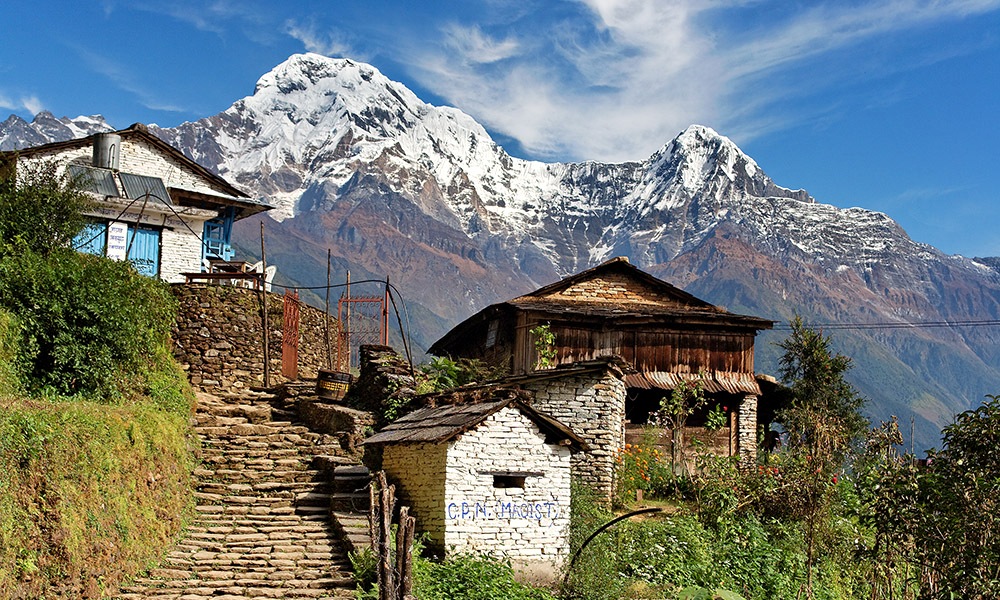
Ghandruk, the famous Gurung village at 2,010m (6,600ft), is located northwest of the lakeside city of Pokhara. It is accessible in one day, with a four to five hour walk after a short ride from the city. Given that the small village is on the much used trail to the Annapurna Sanctuary or the Annapurna Base Camp (also called ‘ABC’ by trekkers), it claims to be the most visited trekking area in Nepal, and is widely known and popular among international visitors. After opening the Pokhara-Baglung highway in the mid 1990s, Ghandruk has seen a gradual increase in domestic tourists as well.
Highlights of Ghandruk
Trek through the beautiful rhododendron forests of the lower Annapurna Region
Visit the Gurung village of Ghandruk, with views of Annapurna and Fishtail
This is one of Nepal’s best short treks, taking you through picturesque villages while offering epic Himalayan views
Popular Route
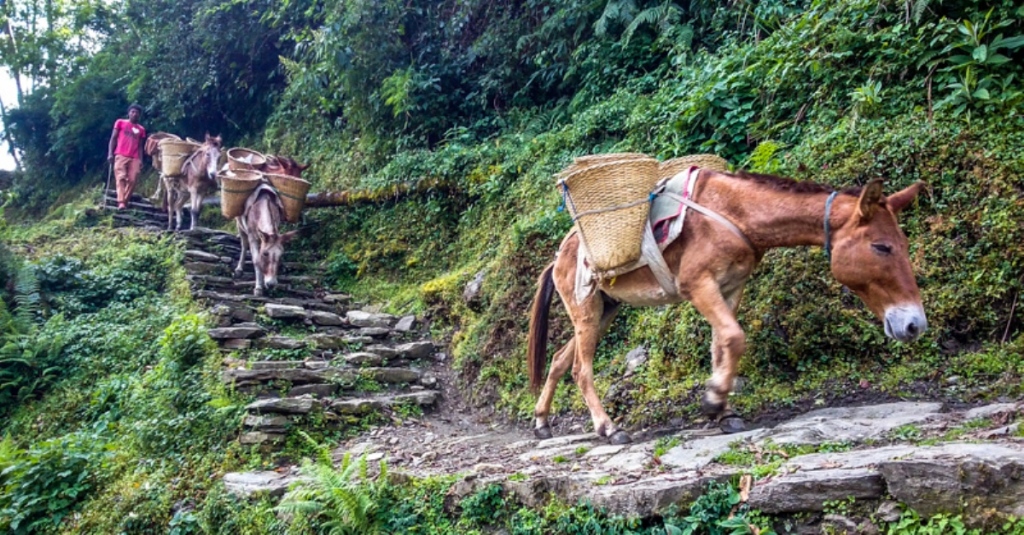
With easy access by road, followed by a short hike of just five hours, and with only a mild physical challenge, Ghandruk as a travel destination is a comfortable bargain. The first leg of the journey begins in Pokhara from where you can drive your own vehicle or hire one or, catch a bus, for the initial 55km trip along the Pokhara-Baglung highway. The road goes up and down with many switchbacks past notable towns like Hyangja, Phedi, Naudanda and through a foggy pine forested highland called Lumle, then down a curvy road to Nayapul, where the hike begins. A steep slope leads to a suspension bridge (the actual naya pul, or ‘new bridge’, when it was built years ago) over the Modi Khola (river). For a half hour, you walk along the Modi Khola to the brisk bazaar of Birethanti.
Old Trail
As you follow the wide path, the river Modi still close to your right roars past going south around the contour of the hill. Where the wider path (a new seven kilometer fair weather road) heads straight up, you’ll see a small placard that reads ‘Old Trail’ pointing a little to the right, to a narrow trail that runs along the riverbank. It’s nothing to get confused about, even if you are a first timer . Both routes converge way up at Syauli Bazaar. If you wish to confirm, the locals around will readily help you out. Naturally, you’ll want to walk the old trail
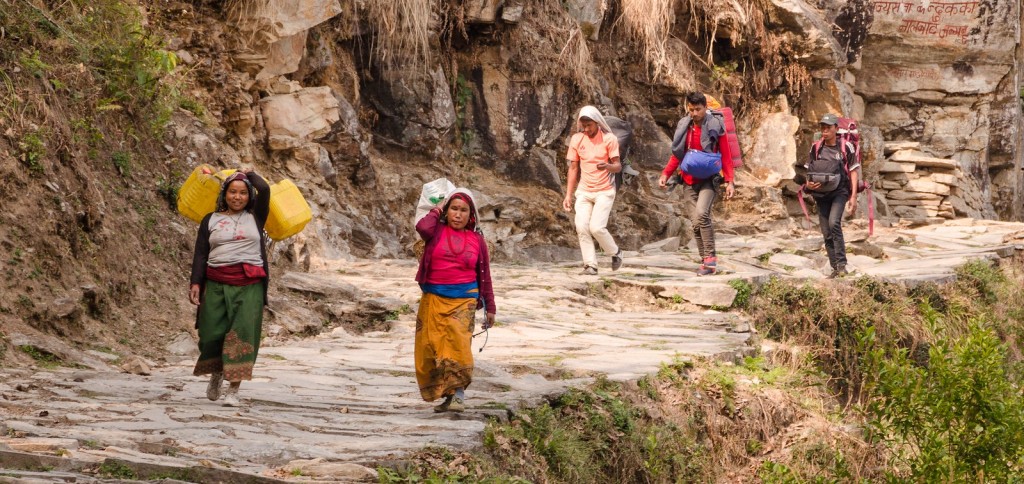
To your left, the hills continue upwards until both the routes meet on the horizon. After something like an hour, you leave Lamakhhet (literally ‘Lama’s Field’), pass a birch forest and arrive at Syauli Bazaar, a small settlement of Gurungs and Magars. There you’ll find a number of shanty houses, tea stalls, and inns. After Syauli Bazaar, the trail runs along the contour of the mountain to the left. The Modi valley, below, keeps you company on the right. All along, the trail winds through terraced fields that flank you on either side; they then gently drop in perfect symmetry to the banks of the Modi at the foot of the hill. From here on, the trail is paved with uneven stones and becomes steeper. The ever-changing and magnificent mountain landscape is beautifully distracting. A word of caution here, as you haul yourself up the uneven and jagged stone stairs that keep you company from here: keep a wary eye on those stone steps and on the copious mule droppings.
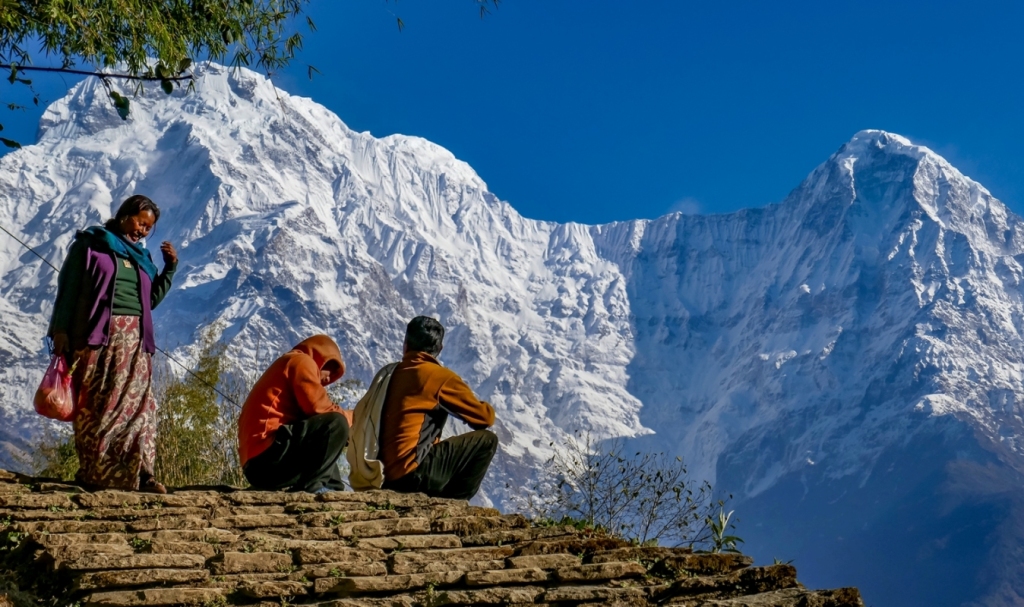
As you carry on up the steep path, you’ll have a closer view of Machhapuchhre, or ‘Fish Tail’ peak at the north, if weather permits. The day we were there, heavy monsoon clouds and haze allowed us only the tip. As the name suggests, the snow-capped peak rearing its two pronged crest truly bears resemblance to a fish’s tail. As you approach a small settlement called Chane, the steepness eases up. Save for a handful of tea houses, Chane otherwise dons an isolated look. After a short while, the trail leads through a jumble of rocks and boulders, the aftermath of a huge landslide that came down in 1995, according to a local villager I spoke with. About a half hour later as you crest a ridge, you will find the path well paved with stones and stairs at irregular intervals. Thereafter, the trail follows the contour of the hill past lush green trees.
There are steel railings along the well-paved wide stone path, which led Bryn Thomas, in his book Trekking in the Annapurna Region, to remark that “The path is reminiscent of remaining parts of the Inca Trail that trekkers still follow on the way to Machu Picchu in Peru.” These railings—on the way to Machhapuchhre in Nepal—continue only for a short stretch, however. The last leg of the hike involves yet more stone steps that lead steeply up the hillside. It seems that the Gurungs like to pave their trails with big stones. A wayside sign reads ‘Ghandruk: 2010m’, as you enter the village. The big Gurung community hugs the hillside gradient and sprawls out in a split-level fashion. Check into a lodge or an inn. They are found at almost every corner. Note that while Ghandruk is a predominantly ethnic Gurung village, other residents include the artisan castes and ethnic Magars. The majority is Buddhist, others are Hindu.
View from Ghandruk Village
The views from Ghandruk are awesome. At the east, terraces drop dramatically into a deep gorge carved by the glacier-fed Modi River. Above the fields, the densely forested hill soars high. That small cluster of dots on the hillside across the valley is Landruk. One route through these hills is popularly called a “loop trek”, whereby trekkers on return from Ghandruk go down the eastern side of the valley through Landruk, Pothana, Deurali, and Dhampus to Phedi at the very top end of the Pokhara valley. To the west, the hills roll up and over, through a high forest, to the famous trekking spots of Ghorepani and Pun Hill. And, looking south, your eyes drop down into the deep valley where the Modi River winds along towards Birethanti and Nayapul.
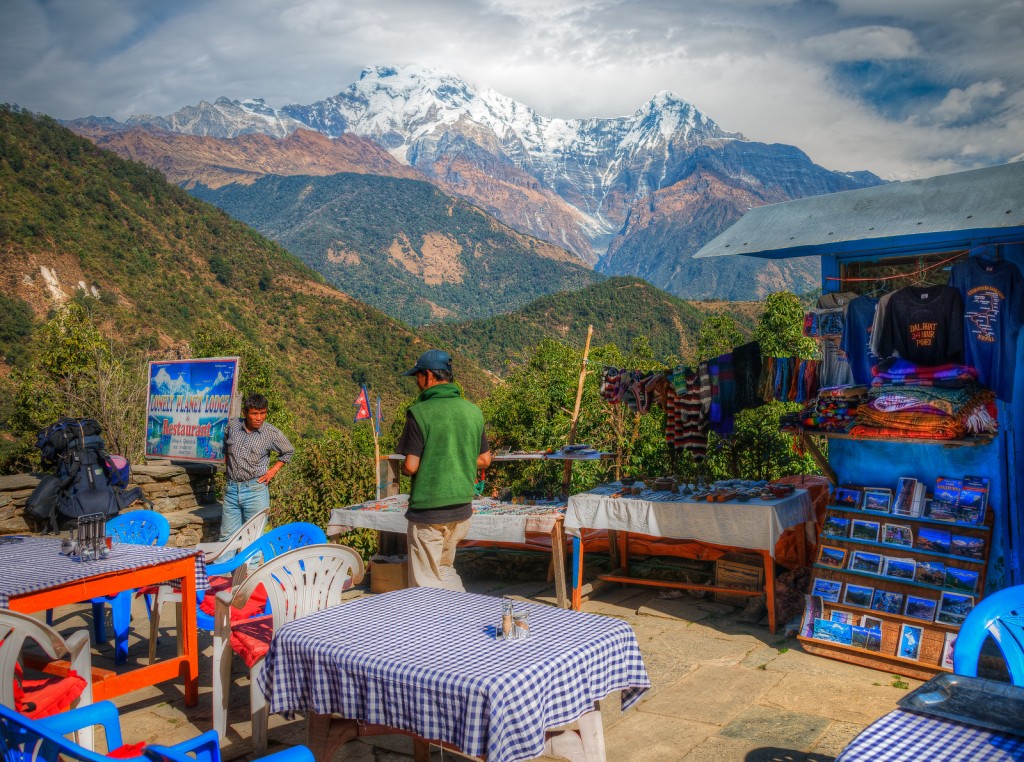
The most spectacular view, however, is northward up to the panoply of craggy snow peaks that solemnly gaze down over this Gurung locale. It is almost hypnotic, as your eyes scan left to right and from down to up to the snowy giants—Machhapuchhre at 6,993m (22,943ft) and her sister peaks: Annapurna III, Gangapurna, Hiunchuli and Annapurna South, ranging in height from 6,441m or 21,132ft (Hiunchuli) to 7,555m or 24,787ft (Annapurna-III). No words can do them justice. The enchantment is complete. And all you can take back are those timeless moments preserved in your camera and your mind. Far and away, Machhapuchhre is the most photographed peak from the vantage of Ghandruk village.
Best time to visit Ghandruk
The Ghandruk trek is pretty easy to finish any time of the year except the rainy seasons. Mid-September until May is the finest season to trek around Annapurna that offer spectacular mountain views along with the astounding natural beauty and the supreme cultural values. Summer (June to July) is also favourable. However, the rainfall makes it a little hard to trek in this region. By taking weather forecast measures, the winter season is also a good time. But the snowfall occurs. So, the best time to trek in this region is from mid-September to May.
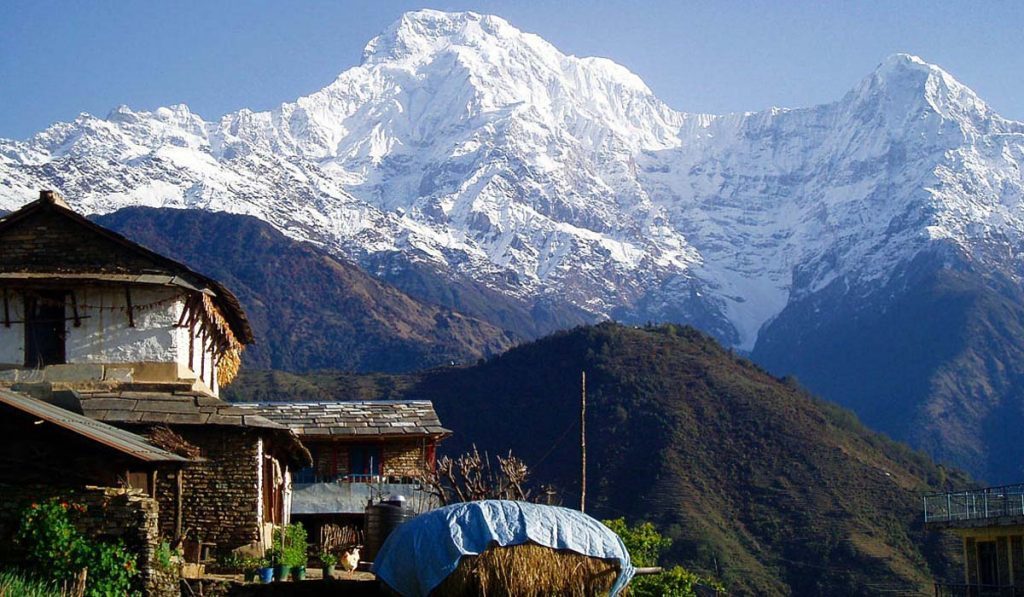
Fitness Level Required
The Ghandruk trek is relatively easy. Each day is only about five-six hours of walking, so you don’t need to be in amazing shape to do this. That said, there are a lot of stairs so be prepared for that. Unlike many treks in Nepal, you don’t have to worry about altitude sickness on this trail. The trek doesn’t go past 2000 meters of elevation.
What to bring on the Ghandruk Trek
You won’t find hotels but you will find small villages with tea houses to stay in all along the trail. You don’t need to worry about bringing food and water, as supplies can be bought at each village, and there are plenty of tea houses to cook you a meal.
Here is a suggested packing list for the Ghandruk Trek. You can always hire a porter if you don’t want to carry your bag.
SPF T-Shirts x3
Pajamas
Hiking Pants X 2
Underwear X 3
Comfortable trekking shoes, and sandals to wear at night
Socks x 3
Packable Down jacket
Sweater
Hat/Scarf/Gloves for night
Toiletries
Sunscreen/Sun hat/Sunglasses
Refillable Water bottle – Use Lifestraw and then you can drink the water along the way
Packable Towel
Sleeping bag – the teahouses provide blankets but they are lightweight and it can be chilly at night
Trekking poles – not essential but can be helpful going downhill
Headlamp
Camera – check my photography guide for the best travel cameras.
Trekking Permit to visit Ghandruk
The most important part of Ghandruk trek is obtaining the required permits. As Ghandruk lies in the Annapurna Conservation area, you need an ACAP (Annapurna Conservation Area Project) entry permit in order to be able to enter the region. Apart from the entry permit, you also need a TIMS (Trekkers Information management System) card which is used to keep track of all the trekkers entering the area. A part of this fee is also maintained to help and rescue trekkers in any adverse situation. Both the permit and TIMS card can be obtained from Nepal Tourism Office in either Kathmandu or Pokhara.
Trekking Permit Fees of Ghandruk
Entry Permit: International – NPR 3000, SAARC – NPR 1000, Nepali – NPR 100
TIMS Card: For each individual trekker: International – NPR 2000, SAARC – NPR 600
Note
Your passport and 4 passport size photographs are needed for procuring the permit and TIMS card. In case, you do not have your photographs handy, you can get your picture taken for free in the office itself. Not only this, but the whole process of permit issue is very smooth and takes hardly half an hour (may take more time in peak season when there are many people around).
Keep the fees in Nepal Currency handy as there is no provision of paying by card. You can also pay by US dollars.
The TIMS card and entry permit can be used only once per trekking route per entry.
Checking for TIMS card happens at the Checkpost in Birethanti and is usually taken care by the bus conductor.
Accommodation in and around Ghandruk
Ghandruk being quite popular among trekkers has many lodge and hotels set up for accommodation. If you look at the board listing all the accommodations at the entrance of the village, there are around 50 of them. So even if you do not book and reach there directly, you can easily get some place to stay in.
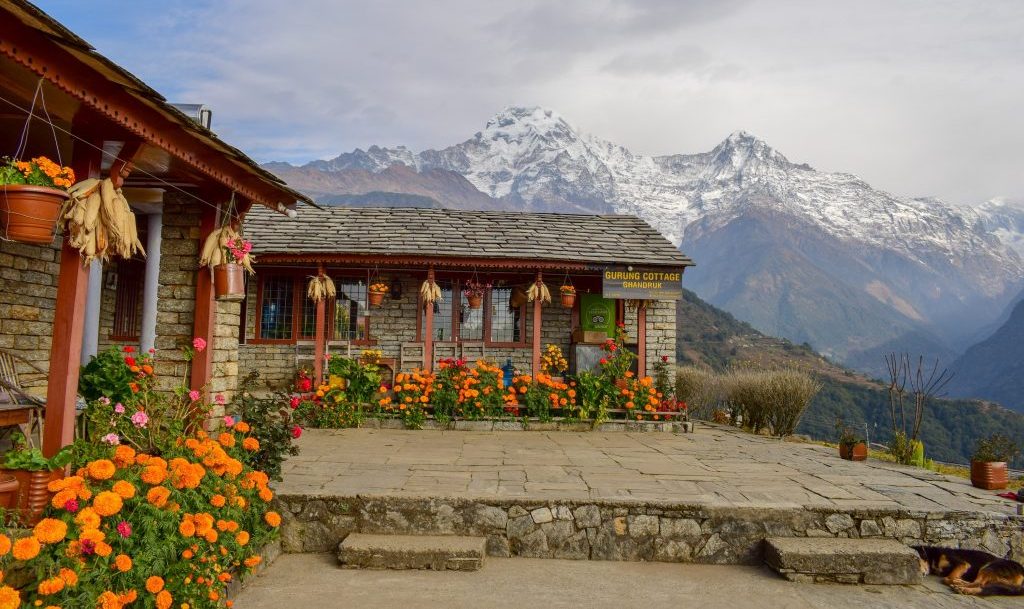
Gurung Cottage and definitely recommend it. The best part of the stay is the gorgeous views all around and the delicious food prepared from organic home grown vegetables. You can contact them on the following numbers for a booking.
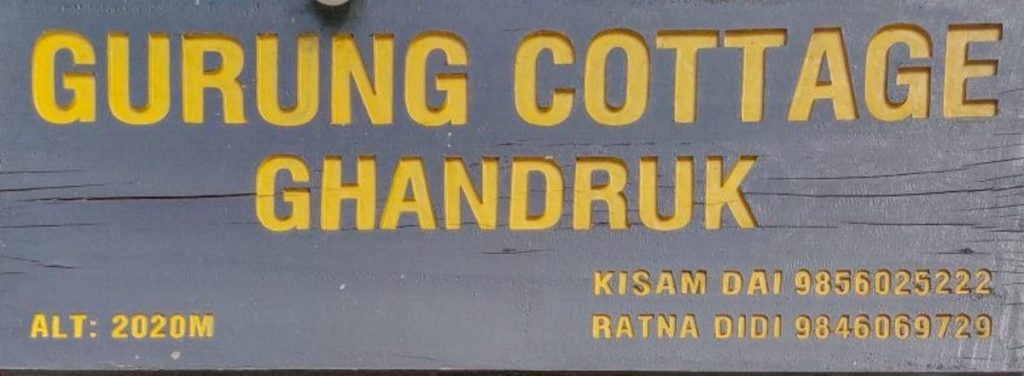
Festival celebrating at Ghandruk
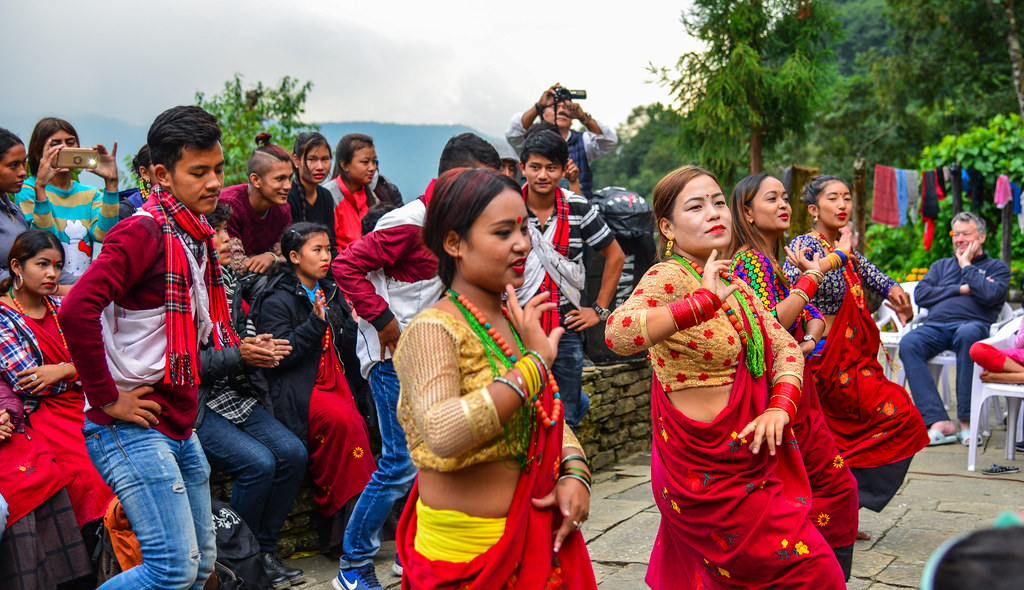
Local people of Ghandruk celebrate different kinds of festival including Dashain & Tihar, Shri Panchami, Teez, and mostly all festivals of Hindu and Buddhism.

